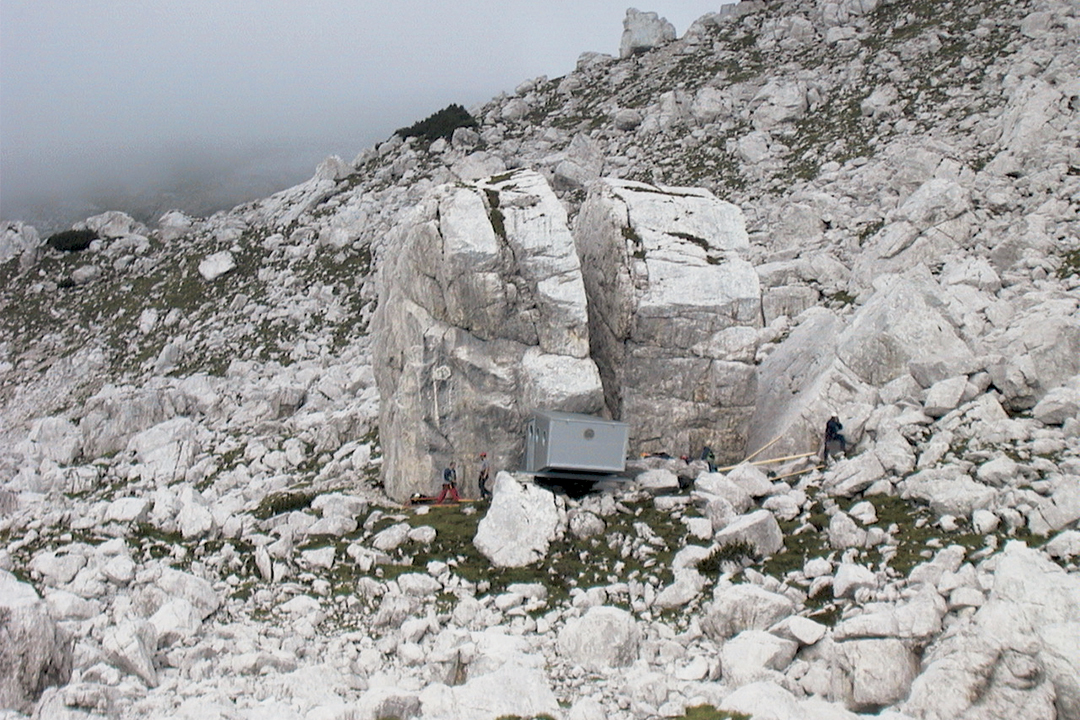The mountainous landscape of the far north-west of the Slovenian part of the Julian Alps is quite wild, dramatic and still almost completely virgin. The mountain paths are demanding, so even experienced mountain climbers have to count on long-lasting treks without the opportunity to make a stop in a climbers’ lodge. It is this distance between mountain peaks and hiking trails coming from the other side that is especially attractive. Kotovo Sedlo (2134 m), from which wide and far views open out, remains hanging some 600 m below Jalovac (2645 m), and a good 1000 m above the Tamar valley, when this valley was dug out by a glacier. Mountain climbers stop here before climbing Jalovec and, in winter time, skiing down from the mountain saddle is still one of the favourite exploits of numerous skiers.
The local mountain rescue service has been planning to put up a new shelter here for a long time. Since the number of visitors is constantly on the rise, the putting up of an emergency refuge hut on Kotovo Sedlo has become of the essence for the security of all mountain climbers. It was destined to serve as protection from dangerous storms and as a resting place in cases of over-tiredness and in cases of rescue, most of all in winter time, to serve as a welcomed shelter before attempting transportation into the valley below.
To set a shelter in virgin mountainous surroundings means to build in the middle of unspoiled nature. Nature, as well as the users, mountain climbers, is the only thing in the mountains that can be and has to be taken into account when building. Even with such a small construction, such as a refuge, we can immediately note an authentic and honest relation of man to nature. It was Adolf Loos, who in his “Rules for Those Building in the Mountains”1, wrote that nature tolerates only sincerity. When building in the mountains we have to do only what is necessary. No more. It is very important not to overdo it, while planning construction in the mountains, said Loos. Building an emergency shelter with minimum funds is inevitably an exercise in building something which is just about satisfactory. How to build something decent and not cross the line of bare necessity?

On challenging mountainous terrain, exposed to rain, wind and avalanches, first the right location had to be chosen. Kotovo Sedlo is a plateau, covered in big chunks of chipped off rocks, resembling a sea of stone, frozen in the middle of wild waves. In the midst of this stone sea, there was one big rock, split open in the middle, almost 20 metres high, a perfect place to set up refuge. A refuge hut was set up under this rock as a sort of a metal zipper preventing the rock from plunging into the valley below.
With his first shelter on Kobariški Stol, Kajzelj showed how to build in the mountains the right way. In comparison to Kobariški Stol, where he tried to make his forms like the broken lines of the ridge, the shelter on Kotovo Sedlo could be just one of the rocks scattered over the mountain range. It is adapted to the physiognomy of the rocks, whose protection it is using.
In the middle of this sea of stone on Kotovo Sedlo, in spite of everything, here architecture is a visual artefact. Actually the refuge is not even trying to hide it, it is as honest as possible in this sense. The reflection of metal cladding between the rocks speaks of the meaning of arational selection of materials, which should guarantee durability in harsh weather and enable easy transport to this not easily accessible location. The shape of a prism should help the materials and structures to endure/resist the elements longer. The materials and straight lines are precisely what makes the shelter seem artificial and in contrast to nature.
Sharply cut edges of lightweight tin façade panels combined with round shaped openings let the visitor know this piece fell down from some other world. This is why this small metal box seems quite honest in the midst of the rocks. It really flew by air. The shelter was completely assembled in the valley and was brought over by helicopter to Kotovo Sedlo as a completed structure. So, on the mountain, it was necessary to do just the works that were needed.